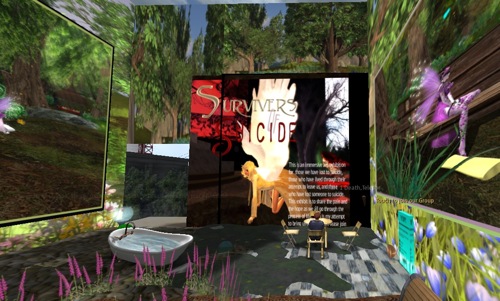1. Second Life Video News -001- 31/7/2009
2. The Wedding of Bobo Denver and Kev Madfes in Second life
3. The Rain ( Second Life )
Tech -- Culture -- Humour
1. Second Life Video News -001- 31/7/2009
2. The Wedding of Bobo Denver and Kev Madfes in Second life
3. The Rain ( Second Life )
 The Lions Club has 1.3 million members across more than 45 thousand clubs worldwide. A secular organisation, its mission is to “empower volunteers to serve their communities, meet humanitarian needs, encourage peace and promote international understanding through Lions clubs”.
The Lions Club has 1.3 million members across more than 45 thousand clubs worldwide. A secular organisation, its mission is to “empower volunteers to serve their communities, meet humanitarian needs, encourage peace and promote international understanding through Lions clubs”.
The latest club being proposed will be located in Second Life, with official endorsement by the Lions organisation. Two information meetings are being held on the 5th August at 9am and 6pm Second Life time (2am and 11am on the 6th August AEST), at the current Lions Club presence in-world. If you’re after more information, contact Simba Jaggernov or Piratelionecu Humphreys in-world.
I don’t think I’m alone in my admiration for the work Lions do in local communities and it’ll be fascinating to see what this club will be able to do.
Suicide remains one of the issues that pretty much everyone feels queasy discussing. For the survivors of suicide, there’s not choice to discuss it and it’s one of two reasons a presence in Second Life has been created.

Located in Haetae, the purpose is is expression and support. There are two floors, Life and Death. Death is an art exhibition depicting the feelings of those considering suicide. The Life section contains some notecards on related area to assist people considering suicide and those that love them.

It’s a confronting exhibit, which is as it should be. It’s not an easy issue in any sense, which makes it all the more important to discuss and raise awareness around. It’d be easy to say there’s nothing in this exhibit that can’t be found in a much more comprehensive form. That would miss the point: every channel of communication that can make a difference is worthwhile, and I’d have some faith that the efforts here will certainly do that.
If you need more information on the project contact Krissy Sinclair in-world.
Since HTTP-in was deployed in the recent Second Life server update, I’ve had a chance to bend, fold, spindle and mutilate it extensively. Essentially to use and misuse it in pretty much every way I could think of. And you know what? It’s nice, but it isn’t that big a deal.
HTTP-in allows an external application to send data to an object in Second Life, just as is done via email and via XML-RPC. About the only thing that HTTP-in seems to really bring to the table is simplicity and reliability. XML-RPC and email communications to in-world objects are highly centralized, slow, and not actually all that reliable. When you combine that with the setup and teardown requirements (both for you, and for the grid itself), things get pretty ugly.
HTTP-in is busting to its veriest seams with caveats, cautions and conditions, but it actually works and it keeps working, which by this stage – six years in now – must seem like a minor miracle at the very least. Frankly, though, the single most effective use is signaling.
Unless you’re intending to pull data out of Second Life, you’re best off retrofitting your code to wait for you to poke it via HTTP-in and have it call your Web-server back to retrieve the data. It’s simple, efficient, faster than pushing data through, generally, and pretty much in 90% of cases that’s actually what you’re doing anyway.
Almost every scripted object using HTTP is pushing or polling – and HTTP-in doesn’t seem to offer enough advantages on its own to make sitting down and turning that model on its head worthwhile. Using the system as an external trigger to tell your in-world objects when to poll? Now that works a treat.
What you definitely need, whatever you do with HTTP-in, is you need some external repository that your in-world object can push its URL to, because HTTP-in URLs are darned ephemeral.
Region restarted? The URL becomes invalid and you have to get a new one. Script reset? Invalid. Teleported? Invalid. On rez? Invalid. Jump to the default state? Invalid. Detached or attached? Well, you get the idea.
Putting in everything to take care of that is wordy, but reusable, and almost all of us who have been using the other communications methods already have an HTTP-accessible registry where our in-world objects can store data like this, so it isn’t that huge a deal.
The number of potential incoming URLs is somewhat limited (limits operate in the same basic allocation fashion as prim-limits, and objects attached to an avatar have a pool of 38 possible URLs available to them). There’s also caps and throttles, but if you’re doing generally sensible communications coding, you won’t run into any of them at present – though there are hints that they may be adjusted in future.
All in all, the primary benefit of HTTP-in seems to be faster and simpler signaling to in-world objects, and that goes a long way towards reducing the level of incoming traffic at your HTTP server – and depending on the strictures of your hosting service, that can be a very good thing indeed. It doesn’t make choirs of angels sing, but it’s still a very useful replacement for email and XML-RPC communications.
1. Associated Content (USA) – Tron Legacy Coming Soon in 2010. “Some test footage from Tron Legacy, the sequel to the 1982 cult classic Tron, was shown at Comic Con 2009. The Tron Legacy footage depicted a battle between a blue and yellow “light cycle”, familiar to those who recall the first film.
Tron was the first film to make heavy use of computer generated images (CGI). Tron depicted the adventures of Flynn, played by Jeff Bridges, a computer programmer who had been literally sucked into a virtual, computer world and forced to fight in deadly arcade like games, such as the light cycle battle, by the Master Control Program, played by David Warner. Flynn was aided by two computer generated characters, Tron, played by Bruce Boxleitner and Yori, played by Cindy Morgan. Tron and Yori had real world counterparts, Alan and Lora, who were Flynn’s friends and also computer programmers.”
2. The Economic Times (India) – Could virtual gaming contribute to medical research? “If twitter is the tech-story turned mainstream media darling of 2009, then San Francisco-based Linden Lab’s virtual reality world “Second Life†(SL) was clearly the fancied one in 2008. There was a bizarre SL related story – virtual rape/murder/suicide – every other day in the papers , CNN and Reuters had news bureaus within SL and journalists were getting invites to attend virtual press conferences in SL from gimmicksavvy tech companies. In 2009, while the limelight has gone and its user base has remained stagnant at about 800,000, Second Life has made that allimportant leap: converting hype into REAL money. Some analysts estimate that it will make a 100 million dollars this year and turn a net profit of about 35 million dollars within two years. The main source of revenue of course is the “real money†users pay to acquire real … err virtual estate in the SL universe. ”
3. The Telegraph (UK) – Addiction therapists signing up to World of Warcraft. “Experts have said that some massively multiplayer online games, in which players battle enemies for weapons and rewards, are as addictive as crack cocaine.
Dr Richard Graham, a consultant psychiatrist at the Tavistock Centre in London, is so concerned that he plans to provide online therapy for youngsters who are spending so much time playing these games that they have lost touch with the real world. A recent report by Sweden’s Youth Care Foundation described World of Warcraft as “more addictive than crack cocaineâ€. The game, which attracts almost 12 million players every month, is set in a fantasy environment, with users taking on the characters of dwarves, elves and wizards, interacting with other players throughout the virtual world.”
4. Computerworld (USA) – Faux pas at virtual world discussion highlight continuing ‘transitional phase’. “Virtual worlds are growing in colleges and universities despite significant problems in using them to teach courses and communicate, a panel of experts said during a virtual discussion sponsored by Cisco Systems Inc. The problems range from giving students and educators access to networks to reach the online virtual worlds to ease-of-use with the applications and tools inside of the virtual worlds, panelists and audience members said. “There’s a long way to go with this technology to make it easy for everybody to do,” said Sarah Smith-Robbins, director of emerging technology for Kelley Executive Partners at the Kelley School of Business at Indiana University. She has taught and written about virtual worlds for six years, and specializes in creating learning experiences that build on virtual worlds and alternative and augmented realities.”
5. The Age (Australia) – ‘Risk illiteracy’ among the young and reckless. “”THE only thing that shakes us is when one of our friends dies,” admits 19-year-old Hamad Al Mazmi in Prahran on a Friday night he has spent riding around in a high-powered Holden ute. The international student’s words are the last thing that police, the Transport Accident Commission and parents of young drivers want to hear. They know they are true. It’s a terrible irony that the deaths of nine young drivers and their passengers in the past month may have done more to teach inexperienced drivers about the fragility of life than could any government-funded campaign or parental tirade.”
6. ZNet – Elites and power. “The following text develops an argument that leads up to the vision of its last paragraph – which, to some, might seem enigmatic or disappointing in its implications. It is all about the concept of planning – of participatory or democratic or, as I would prefer to call it, scientific (interdisciplinary) planning. It is about the multitude of experts, scientists and professionals that are involved in the incredibly complicated planning processes of today. How to move from ‘here’ (private ownership of the means of production, corporate divisions of labor, plutocracy, the specter of markets, autocratic planning) to ‘there’ (a socialism based on science, knowledge, reason) is the central question. And you can’t move without movers. Writing about a strategy for the future cannot compel a European of my generation to dismiss the lessons of 20th century’s Left Project, which started out under the banner of ‘scientific socialism’ – and dismally failed. But do we refrain from returning to classical art and thought just because the project of classical antiquity ‘failed’? To Karl Marx and Friedrich Engels and to thousand other thinkers the concept of scientific socialism was essential. And many think, that advances in the soft and hard sciences are such that this concept finally has a chance. ”
7. Top Tech News (USA) – Collaboration Tools Can Cut Costs, Boost Productivity. “At a time when enterprise software investments are trending town, companies may not be looking to invest in unified communications and collaboration tools. But with the boost to business productivity, the contained costs, and the chance to be a good corporate citizen by reducing your company’s carbon footprint, it may be time to look at how collaboration tools — both enterprise-level and low-cost open-source solutions — can benefit your company. “Providing employees with collaboration tools that enable them to work together effectively, no matter where they may be located, is no longer a wish-list or nice-to-have item — it’s a requirement,” said Kent Erickson, senior vice president and general manager of Workgroup Solutions for Novell.”
8. North Shore Times (NZ) – Study out of this world. “Virtual worlds and computer games aren’t only for teen cyberjunkies, says Massey University associate professor Erik Champion. He says computer games have enormous potential and tools to explore and interact with ancient cultures, distant places and inaccessible environments. The new media lecturer at the design school on the Albany campus is seeking designers to create more New Zealand-themed virtual worlds. “The challenge is to find new interactive ways to experience things through digital media,” he says. Dr Champion says those worlds will soon become more popular than travelling and book learning and the like.”
9. The Economist (USA) – Online playgrounds. “REMEMBER Second Life, the virtual world that was supposed to become almost as important as the first one? Now populated by no more than 84,000 avatars at a time, it has turned out to be a prime example of how short-lived internet fads can be. Yet if many adults seem to have given up on virtual worlds, those that cater to children and teenagers are thriving. Several have even found a way to make money. In America, nearly 10m children and teenagers visit virtual worlds regularly, estimates eMarketer, a market researcher—a number the firm expects to increase to 15m by 2013. As of January, there were 112 virtual worlds designed for under-18s with another 81 in development, according to Engage Digital Media, a market research firm. All cater to different age groups and tastes. In Club Penguin, the market leader, which was bought by Disney in 2007 for a whopping $700m, primary-school children can take on a penguin persona, fit out their own igloo and play games. Habbo Hotel, a service run from Finland, is a global hangout for teenagers who want to customise their own rooms and meet in public places to attend events. Gaia Online, based in Silicon Valley, offers similar activities, but is visited mostly by older teens who are into Manga comics.”
10. VentureBeat (USA) – Do you have the right to socialize on multiplayer games? ““Erik Estavillo is suing Sony over being banned from PlayStation Network, claiming that the company violated his right to free speech and has caused him pain by removing his only form of socialization, as he suffers from agoraphobia.†When I first read about this lawsuit, I wondered if the plaintiff in the case filed his suit pro se — representing himself. My thought was that any attorney who represented him might be subject to professional discipline for bringing a meritless claim. A suit that blatantly lacks jurisdiction would probably fall under that category. On second review though, I thought that there might be a colorable basis for this suit, enough jurisdiction for the lawyer to avoid censure at least. The plaintiff’s complaint doesn’t specify exactly how Sony’s Resistance: The Fall of Man (RFoM) game platform qualifies as a “public forumâ€, but this point will determine whether the court can even entertain the case.”
At Sunday church the local Vicar explains that he must move on to a larger congregation that will pay him more.
There is a hush within the congregation. No one wants him to leave because he is so popular.
Fred Smith, who owns several car dealerships in Southland and Otago, stands up and proclaims: ‘If the Vicar stays, I will provide him with a new Holden every year and his wife with a Honda mini-van to transport their children!’
The congregation sighs in appreciation and applauds.
Sam Brown, a successful entrepreneur and publican, stands and says, ‘If the Vicar will stay on here, I’ll personally double his salary and establish a foundation to guarantee private secondary school education of his children!’
More sighs and loud applause.
Agnes Jones, age 88, stands and announces with a smile, ‘If the Vicar stays, I will give him sex.’
There is total silence.
The Preacher, blushing, asks her:
‘Mrs. Jones, you’re a wonderful and holy lady, whatever possessed you to say that?’
Agnes’s 90-year old husband, Joe, is now trying to hide, holding his forehead with the palm of his hand and shaking his head from side to side, while his wife replies: ‘Well, I just asked my husband how we could help, and he said, ‘Fuck him’.
1. Led Zeppelin (Second Life)
2. Metropolis in Second Life…Coming Soon!
3. Waterslide to Heaven (Second Life)
 I like Mark Colvin’s style of journalism a lot – PM is arguably one of Australia’s best sources of current affairs to be found, and its ongoing success is at least partly due to its host. He also happens to be pretty tech savvy and is one of Australia’s more engaging people on Twitter.
I like Mark Colvin’s style of journalism a lot – PM is arguably one of Australia’s best sources of current affairs to be found, and its ongoing success is at least partly due to its host. He also happens to be pretty tech savvy and is one of Australia’s more engaging people on Twitter.
Today, PM looked in depth at Second Life and virtual worlds more broadly. Specifically, Colvin interviews Thomas Malaby, whose recent book has garnered a lot of attention for its in-depth ethnographic analysis of Linden Lab.
The fifteen-plus minutes of interview is more than worth listening to for its insights, particularly for the newer virtual worlds user. For the more experienced, Malaby still provides some great thoughts on avatar as personality, addiction, the health benefits of virtual worlds and quite a bit more. Listen to the lot here. The shorter version broadcast on PM can be found on the same page.
A big thanks to Wolfie Rankin for the heads-up.
Update: Mark Colvin has now blogged his thoughts on virtual worlds here.
 1. ABC Island‘s friends are seeking feedback on the new Pool Studio. It features a green screen area for Machinima production and a cinema section where we hope to stream video shortly.
1. ABC Island‘s friends are seeking feedback on the new Pool Studio. It features a green screen area for Machinima production and a cinema section where we hope to stream video shortly.
2. Interested in helping entrepreneurs in developing countries? Our Metaverse Aid team is growing slowly and more than a dozen ventures have been funded to date. Why not join us?
3. There’s lots of buzz around the US Government’s Deputy CTO, Beth Noveck, who’s a long-tim Second Life resident who is still dropping in regularly.
4. Second Nights is a new website / social network for those who enjoy Second Life’s entertainment on offer. A ‘finder’ feature for artists, clubs, DJs and more is available.

5. The 2009 Relay for Life in Second Life has completed, with more than US 260 thousand dollars raised. Here’s one Australian blog devoted to raising awareness of the event.
6. Tateru Nino has Ten Great Tips for New Second Life Users that are well worth reading.
Copyright © 2024 · Magazine Child Theme on Genesis Framework · WordPress · Log in
Recent Comments